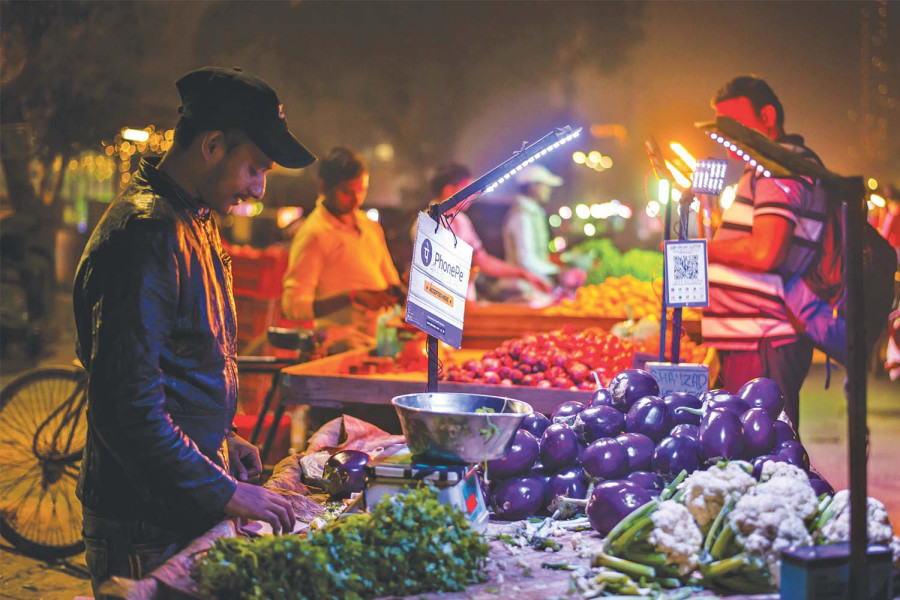Money
Nepal permits QR code payment in India and Bhutan
Nepali payment system operators say they will soon begin the service in India. The daily transaction limit for merchant payment is Rs15,000 or Rs100,000 per month.
Krishana Prasain
Three months after Indian citizens were allowed to make payments through their mobile phones in Nepal, the central bank on Thursday permitted Nepali citizens to use a quick response (QR) code payment system in India.
In a Thursday circular, Nepal Rastra Bank said it has allowed merchant payment using QR codes and other payment mediums like e-banking, interbank payment, and mobile banking in India and Bhutan.
The daily transaction limit for merchant payment is Rs15,000 or Rs100,000 per month. A merchant transaction refers to any payment made by a customer to a business or seller. The service has been opened only for goods and service payments in India.
With Nepal’s central bank allowing cross-border payment, Nepali payment system operators say they would begin the service in India soon.
In a separate circular, the central bank said that Nepali companies involved in digital cross-border payment systems should get prior approval from Nepal Rastra Bank to sign a memorandum of understanding with foreign partners.
“We were allowed to receive the payment by the Indian citizens using QR codes in Nepal. Now, the new provision has allowed the banking and financial institutions associated with Fonepay to make payments using QR codes through their respective mobile banking apps in India,” said Paras Kunwar, Chief Operating Officer (COO) of Fonepay.
“We will soon begin the service for Nepalis in India.”
“Besides a few document works, we are technically ready,” Kunwar said.
Starting March 1, Indians were allowed to make payments through their mobile phones. The development was hailed as a milestone in cross-border digital payment between Nepal and India, facilitating the students and people going to India for medical purposes.
Nepal’s Fonepay Payment Service has partnered with India’s NPCI International Payments to launch the cross-border payment service using quick response (QR) codes.
According to officials, Nepal’s central bank has introduced a retail payment switch to facilitate person-to-person transactions. Nepal Clearing House, a public limited company, can also transact through the retail payment switch.
With the delay in implementing the National Payment Switch, the central bank has provisioned a retail switch for inter-country payment through a quick QR code system.
On March 15, Nepal Rastra Bank amended the inter-country payment system through QR code guidelines and introduced a provision for Indian workers in Nepal who have accounts in Nepali banks to send money through e-banking, interbank payment, mobile banking, and QR code to Indian banks and financial institutions through the national payment switch.
However, a circular published on Thursday provisioned sending money through the retail payment switch until the national payment switch comes into full operation.
The central bank has set a limit of INR15,000 per day or INR100,000 monthly for person-to-person (P2P) transfers, which are electronic money transfers between individuals through an intermediary.
Laxmi Prasad Prasai, director of Nepal Rastra Bank’s payment department, said the national payment switch may take longer.
“The national payment switch has not been finalised. Once the switch is completed, the retail payment switch will be routed through it.”
National payment switch is the core infrastructure for routing and settlement of retail transactions, ensuring the interoperability of card and non-card-based payments within Nepal. It includes a retail payment switch for handling retail (non-card) based transactions and retail instruments.
The retail payment switch is an operational real-time retail payment switch with additional instruments to support virtual private address-based payment, request-to-pay-based pull transactions, interoperable QR, biller gateway, wallet interoperability, and payment system operator settlements.
Card switches and domestic card schemes are currently being implemented.
While sending remittances from India to Nepal under the ‘Indo-Nepal Remittance Facility Scheme’, Nepali citizens who have accounts in Indian banks and financial institutions can send remittances to Nepal using e-banking, interbank payment, mobile banking and QR codes through retail payment switch.
The new guideline issued on Thursday states that remittances sent from India will be available in the Nepali currency in the beneficiaries’ bank account or e-wallet.
The central bank’s circular states that the concerned banking and financial institutions and payment service providers need to minimise all risks and maximise the benefits of digital transactions.
The new amended guideline provides merchant payment for the sale of goods and services by Nepali traders through QR code and other digital payment modes from Indian payment instruments issued.
Nepal’s central bank has already opened the digital payment system for third countries, allowing foreign citizens to pay through a QR code for purchases in Nepal.




 14.12°C Kathmandu
14.12°C Kathmandu














